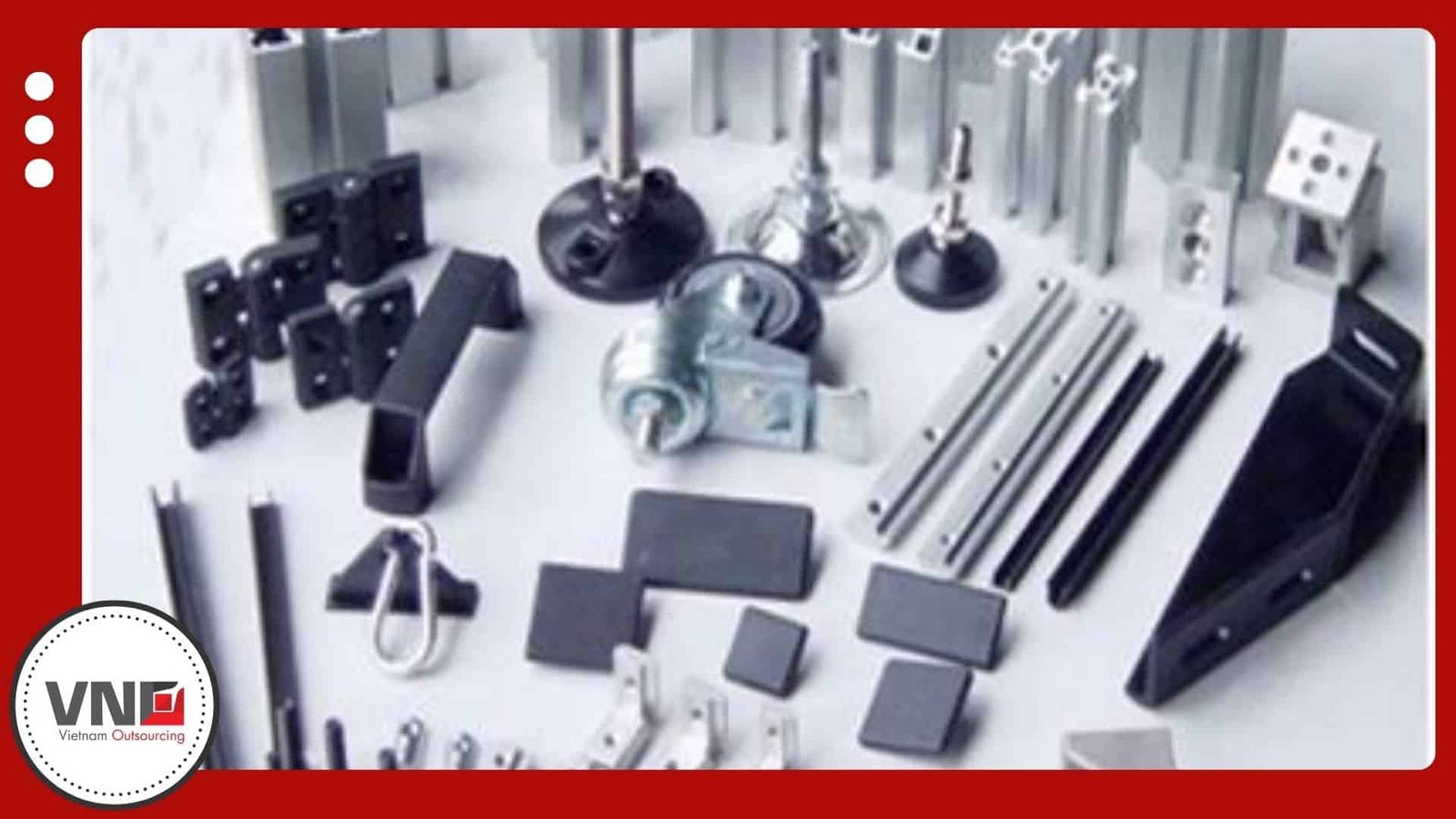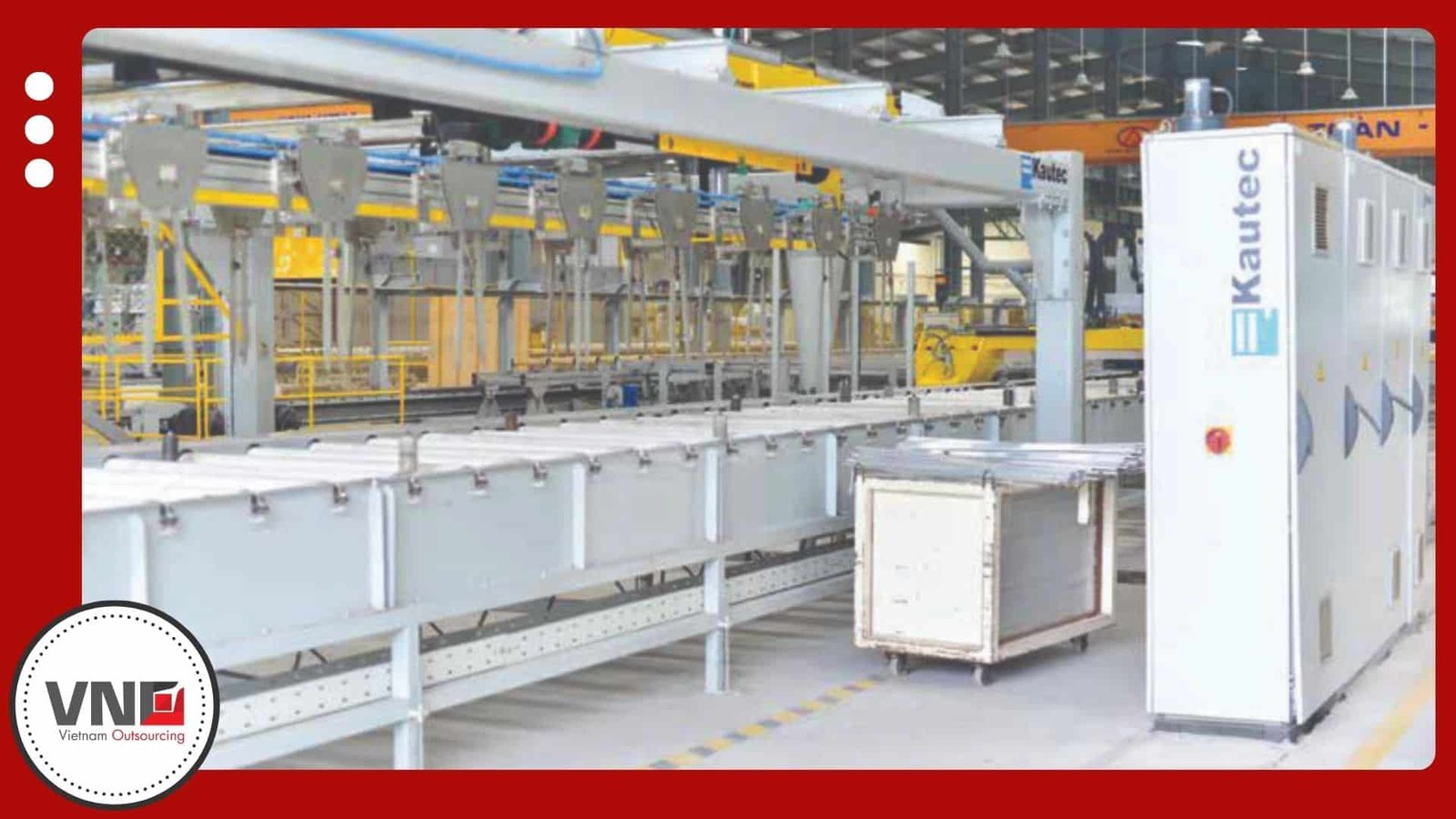- September 8, 2025
- Daniel Pham
Aluminum Manufacturing Vietnam: Outsourcing Partner
Table of Contents
Aluminum manufacturing Vietnam is quickly growing into a major global sourcing hub, giving U.S. and EU buyers a strong mix of low cost, good quality, and trusted standards. Even though the recent 20% U.S. tariff on Vietnamese aluminum adds price pressure, the government and local factories have answered with upgrades, greener production, and closer alignment to global rules.
From extrusion and casting to machining and finishing, Aluminum Extrusion Manufacturers in Vietnam—across both north and south—is shaping up as a reliable “China+1” option. Vietnam Outsourcing (VNO) plays a key role in connecting Western buyers with trusted Vietnamese factories, while also helping them deal with tariffs, technical needs, and quality checks.
Why Vietnam for Aluminum Manufacturing
- Competitive Costs: Even post-tariff, production costs in Vietnam remain lower than China or India.
- Skilled Workforce & Infrastructure: Nationwide investments in training support high-precision work across extrusion, machining, and finishing. See more of Vietnam Aluminum process and technique in 2025
- Trade Agreements: EVFTA, CPTPP, and RCEP strengthen Vietnam’s global access.
- Government Support: Incentives, upgraded industrial zones, and green initiatives make Vietnam increasingly attractive to Western clients.
Impact of Tariffs & Trade Dynamics
The U.S.’s 20% aluminum tariff affects pricing, but Vietnam remains competitive, especially compared to China. Key compensations include:
- Transition to low-carbon manufacturing to satisfy EU CBAM.
- Logistics upgrades for smoother global delivery.
- Administrative strengthening for compliance with Western import standards.
VNO supports clients in mitigating tariff-related challenges via strategic supply planning and cost optimization.
Vietnam Aluminum Main Products and Export Destinations
Vietnam’s aluminum manufacturing ecosystem offers:
- Extrusion profiles: Structural and architectural components.
- Variable Aluminum Alloy Materials: Suitable for welding, construction, and industrial use.
- Solar components: Such as frames, clamps, and heat sinks.
- Machined parts: Enclosures and parts for consumer, electronics, and automotive sectors.
- Surface-treated products: Powder-coated, anodized, or PVDF-finished items that meet aesthetic and durability standards.

Export destinations:
- The U.S. imports over $140 million annually from Vietnam’s aluminum sector.
- Aluminum wire and cable exports to the U.S. have more than doubled recently.
- The EU offers zero-tariff entry under EVFTA, boosting competitiveness against Chinese suppliers.
Industry Applications
Vietnamese aluminum products serve diverse industries:
- Construction: Doors, frames, curtain walls.
- Automotive & EV: Lightweight, high-strength components.
- Renewables: Solar panel mounting systems.
- Electronics & Appliances: Housings, heat sinks, precision components.
- Aerospace & Defense: MIL-grade profiles for critical applications.
Vietnam vs. Other Markets
| Market | Strengths | Challenges |
|---|---|---|
| China | Massive scale and ecosystem | Higher tariffs, rising costs, IP concerns |
| India | Low cost, growing capacity | Quality variability, long lead times |
| Vietnam | Balanced cost, quality, compliance | Tariff impact—but softened by policy and VNO support |
With VNO’s partnership, buyers not only harness Vietnam’s strengths but also strategically manage inherent challenges.
Manufacturing Strength & Regional Capabilities
Vietnam’s aluminum manufacturing sector is both expansive and technologically advanced. To begin with, there are over 100 factories nationwide, producing more than 1.2 million tons per year.
In the south, powerhouses in Dong Nai, Long An, and Ha Nam consistently export at least 5,000 tons per month. These facilities also benefit from European-imported extrusion lines, automated surface finishing, and large-scale production systems, which together boost both output and quality.
Meanwhile, in the north, capacity is expanding rapidly. For example, East Asia Aluminum in Hai Duong province increased its output to 60,000 tons in 2024 and, with Phase 3 expansion, plans to reach 150,000 tons annually. In addition, Ngoc Diep’s Dinostar Factory in Hung Yen now operates as the country’s largest aluminum facility, covering 120,000 m² and featuring fully integrated systems—from billet casting to powder coating—which drives advanced capacity for northern Vietnam.
Furthermore, industrial hubs such as Hanoi, Hai Phong, and Hung Yen are gaining importance thanks to lower labor costs, well-developed industrial parks, and improving infrastructure. As a result, the north is increasingly complementing the south in creating a balanced, nationwide aluminum supply chain.

Quality Standards & Compliance
Vietnamese factories rigorously comply with global quality expectations:
- ISO 9001, ISO 14001, IATF
- Precision control via FAT, PPAP, AQL, MSA, SPC
- Compliance with CBAM, ASTM, GIS, GB, MIL, DEF standards
VNO ensures supplier alignment with these systems, guaranteeing transparency and confidence to international buyers.
VNO’s Role in Vietnam Aluminum Manufacturing
VNO acts as an essential bridge for Western buyers by providing:
- Supplier vetting tailored to technical, capacity, and compliance standards.
- Engineering support to ensure specifications and drawings align precisely with client needs.
- Quality oversight, including FAT, PPAP, and AQL coordination.
- Risk mitigation: managing tariffs, logistics, and compliance.
- End-to-end coordination: from factory floor to port, ensuring traceable and reliable delivery.
VNO simplifies complexity and strengthens trust in Vietnam’s aluminum manufacturing ecosystem.
Conclusion
Vietnam’s aluminum manufacturing landscape—from advanced southern hubs to emerging northern powerhouses—is resilient, compliant, and cost-effective. Despite tariff challenges, progress in technology, capacity, and green compliance makes Vietnam a strong sourcing choice.
With VNO as your strategic outsourcing partner, you gain access to trusted factories, engineering precision, and dependable supply—all tailored for scalable, compliant manufacturing.
Want to dive deeper? Check out our full guide: Everything You Need to Know About Aluminum Industry and stay ahead in global sourcing.
FAQs On Vietnam Aluminum Manufacturing
1. Why should companies choose aluminum manufacturing in Vietnam despite U.S. tariffs?
Even with the 20% tariff, Vietnam remains cost-competitive compared to China and India. Buyers also benefit from compliance with ISO, IATF, and CBAM standards, plus a reliable supply chain.
2. What aluminum products do Vietnam manufacturers export the most?
Vietnamese factories mainly export aluminum extrusion profiles, alloy ingots, wires, solar components, and machined parts. The main markets are the U.S. and EU.
3. What industries use aluminum manufacturing from Vietnam?
Key industries include construction, automotive and EV, renewable energy, electronics, aerospace, and defense.
4. What standards do Vietnam aluminum manufacturers follow?
Suppliers comply with ISO 9001, ISO 14001, IATF, ASTM, CBAM, MIL, and DEF standards, along with quality control systems such as FAT, PPAP, AQL, MSA, and SPC.
5. How does Vietnam Outsourcing (VNO) help companies work with Vietnam aluminum manufacturers?
VNO vets suppliers, ensures engineering alignment, manages compliance and quality inspections, and handles logistics to reduce risks for U.S. and EU buyers.
Ready to outsource aluminum manufacturing in Vietnam? Contact VNO today for compliant, efficient, and high-capacity solutions you can trust.


